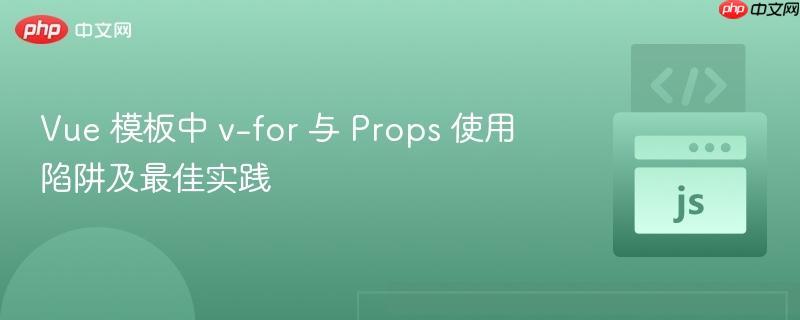
在 vue 模板中使用 `v-for` 循环渲染元素时,直接通过 `this.propname` 访问组件属性(props)可能会导致 `undefined` 错误。本教程将深入分析 vue 模板中 `this` 上下文的特殊性,演示如何正确地在 `v-for` 循环内引用 props,避免常见陷阱,确保数据流的顺畅与应用的稳定性。
Vue.js 提供了强大的模板语法,使得数据绑定和组件渲染变得高效便捷。然而,在将静态渲染逻辑重构为动态 `v-for` 循环时,开发者有时会遇到 `props undefined` 的错误。这通常是由于对 Vue 模板中 `this` 上下文的误解所致。本文将通过一个具体的案例,详细阐述这一问题的原因,并提供清晰的解决方案和最佳实践。
问题现象:v-for 循环中的 Props 访问异常
当一个 Vue 组件在不使用 v-for 的情况下能正常接收并显示父组件传递的 Props,但在引入 v-for 循环后,相同的 Props 却报告 undefined 错误时,这通常指向一个特定的问题。
考虑以下组件代码片段,它旨在展示一系列英雄图标,每个图标对应一个位置(如 TOP, JGL 等)。
原始(工作正常,无 v-for)模板代码:
<template> <div class="champsIconsSelection"> <button class="champIconSelection" :class="{[lado]: true, picked: (this.rolePicked==='TOP'), setted: (this.champsPicked[0] !== 0)}" @click="pickRole('TOP')"> <img :src="'/static/icons/'+ this.champsPicked[0] +'.jpg'" v-if="this.champsPicked[0] !== 0"> </button> <button class="champIconSelection" :class="{[lado]: true, picked: (this.rolePicked==='JGL'), setted: (this.champsPicked[1] !== 0)}" @click="pickRole('JGL')"> <img :src="'/static/icons/'+ this.champsPicked[1] +'.jpg'" v-if="this.champsPicked[1] !== 0"> </button> <!-- ... 其他按钮类似 ... --> </div> </template>
上述代码在没有 v-for 的情况下能够正常工作,lado, rolePicked, champsPicked 等 Props 都能被正确访问。然而,当为了提高效率和可维护性而引入 v-for 循环时,问题就出现了。
立即学习“前端免费学习笔记(深入)”;
引入 v-for 后(导致错误)的模板代码:
<template> <div class="champsIconsSelection"> <div v-for="position in positions" v-bind:key="position.pos"> <button class="champIconSelection" :class="{[lado]: true, picked: (this.rolePicked && this.rolePicked===position.role), setted: (this.champsPicked[position.pos] !== 0)}" @click="pickRole(position.role)"> <img :src="'/static/icons/'+ this.champsPicked[position.pos] +'.jpg'" v-if="this.champsPicked[position.pos] !== 0"> </button> </div> </div> </template>
此时,控制台会报告 this.rolePicked 或 this.champsPicked 为 undefined 的错误。
组件脚本部分(Props, Data, Methods):
<script> export default { name: 'champ_selector', props: ['lado', 'rolePicked', 'champsPicked'], data () { return { positions: [ { 'pos': 0, 'role': 'TOP' }, { 'pos': 1, 'role': 'JGL' }, { 'pos': 2, 'role': 'MID' }, { 'pos': 3, 'role': 'ADC' }, { 'pos': 4, 'role': 'SUP' } ] } }, methods: { pickRole (role) { this.$emit('pickRole', role) } } } </script>
父组件如何传递 Props:
<template> <main> <div id="champZone"> <div id="blueChampSelect"> <champSelect :lado="'blue'" :rolePicked="b_rolePicked" :champsPicked="b_champsPicked" @pickRole="pickRoleB"></champSelect> </div> <!-- ... 其他部分 ... --> </div> <dataZone></dataZone> </main> </template> <script> import champList from './ChampList.vue' import champSelect from './ChampSelect.vue' import dataZone from './DataZone.vue' export default { data () { return { b_rolePicked: '', r_rolePicked: '', b_champsPicked: [0, 0, 0, 0, 0], r_champsPicked: [0, 0, 0, 0, 0], roledict: {'TOP': 0, 'JGL': 1, 'MID': 2, 'ADC': 3, 'SUP': 4} } }, components: { champList, champSelect, dataZone } } </script>
问题分析:Vue 模板中的 this 上下文
Vue 模板在编译时会将其内容转换为渲染函数。在这个渲染函数中,Vue 会自动将组件实例的 data、props、methods 和 computed 属性注入到其作用域中。这意味着在模板表达式中,你可以直接通过名称访问这些属性,而不需要显式地使用 this 前缀。
例如,如果你的组件有一个名为 message 的 Prop,在模板中你只需写 {{ message }} 而不是 {{ this.message }}。同样,如果有一个名为 count 的 data 属性,直接使用 {{ count }} 即可。
虽然在某些情况下(例如在事件处理函数中调用方法),this 可能看起来是有效的,但最佳实践是避免在模板中显式使用 this 来访问 props 或 data。当 Vue 模板被编译时,它会为每个 v-for 迭代创建一个独立的上下文。在这个上下文中,props 和 data 已经被代理到当前作用域,所以 this 可能会引用到不正确的上下文,或者在严格模式下导致 undefined 错误。
在本例中,当 v-for 循环被引入时,尽管 lado, rolePicked, champsPicked 是作为 Props 传递的,但在循环内部尝试通过 this.rolePicked 访问时,Vue 内部的上下文处理机制可能导致 this 无法正确解析到组件实例上的 rolePicked 属性,从而报告 undefined。
解决方案:移除 this. 前缀
解决这个问题的方法非常直接:在 Vue 模板中,当访问组件的 Props 或 Data 属性时,直接使用它们的名称即可,无需添加 this. 前缀。
将出错的 v-for 模板代码修改如下:
修正后的模板代码:
<template> <div class="champsIconsSelection"> <div v-for="position in positions" v-bind:key="position.pos"> <button class="champIconSelection" :class="{[lado]: true, picked: (rolePicked && rolePicked===position.role), setted: (champsPicked[position.pos] !== 0)}" @click="pickRole(position.role)"> <img :src="'/static/icons/'+ champsPicked[position.pos] +'.jpg'" v-if="champsPicked[position.pos] !== 0"> </button> </div> </div> </template>
请注意,this.rolePicked 被改成了 rolePicked,this.champsPicked 被改成了 champsPicked。移除 this. 后,Vue 编译器能够正确地将这些变量解析为组件的 Props,从而消除 undefined 错误。
注意事项与最佳实践
- 模板中 Props 和 Data 的访问方式:
- 在 Vue 模板中,props 和 data 中的属性可以直接通过名称访问。
- methods 中的方法也直接通过名称调用,但如果方法内部需要访问 data 或 props,则在方法内部需要使用 this。
- 例如:<button @click=”myMethod(propValue)”>,myMethod 内部可能是 this.someData = this.someProp + 1。
- 保持模板简洁:避免在模板中添加不必要的 this. 前缀,这不仅能解决上述问题,还能使模板代码更加简洁、易读。
- v-for 的 key 属性:在 v-for 循环中,始终为每个迭代项提供一个唯一的 key 属性。这有助于 Vue 追踪每个节点的身份,从而优化渲染性能和状态管理。本例中 v-bind:key=”position.pos” 是正确的做法。
- 调试 undefined 错误:当遇到 undefined 错误时,首先检查变量是否正确定义和传递。对于 Props,确保父组件正确绑定,并且子组件正确声明。其次,检查模板中的访问方式,尤其是在 v-for 循环或复杂表达式中。
总结
Vue 模板的灵活性有时会带来一些细微的陷阱。在 v-for 循环中访问组件 Props 时,避免使用 this. 前缀是解决 undefined 错误的关键。Vue 模板的编译机制会自动将 Props 和 Data 代理到模板作用域,使得直接访问成为可能且是推荐的做法。遵循这些最佳实践,不仅能避免常见的运行时错误,还能让你的 Vue 应用代码更加健壮、高效和易于维护。通过理解 Vue 的内部工作原理,我们可以更好地利用其特性,构建出高性能的单页应用。


